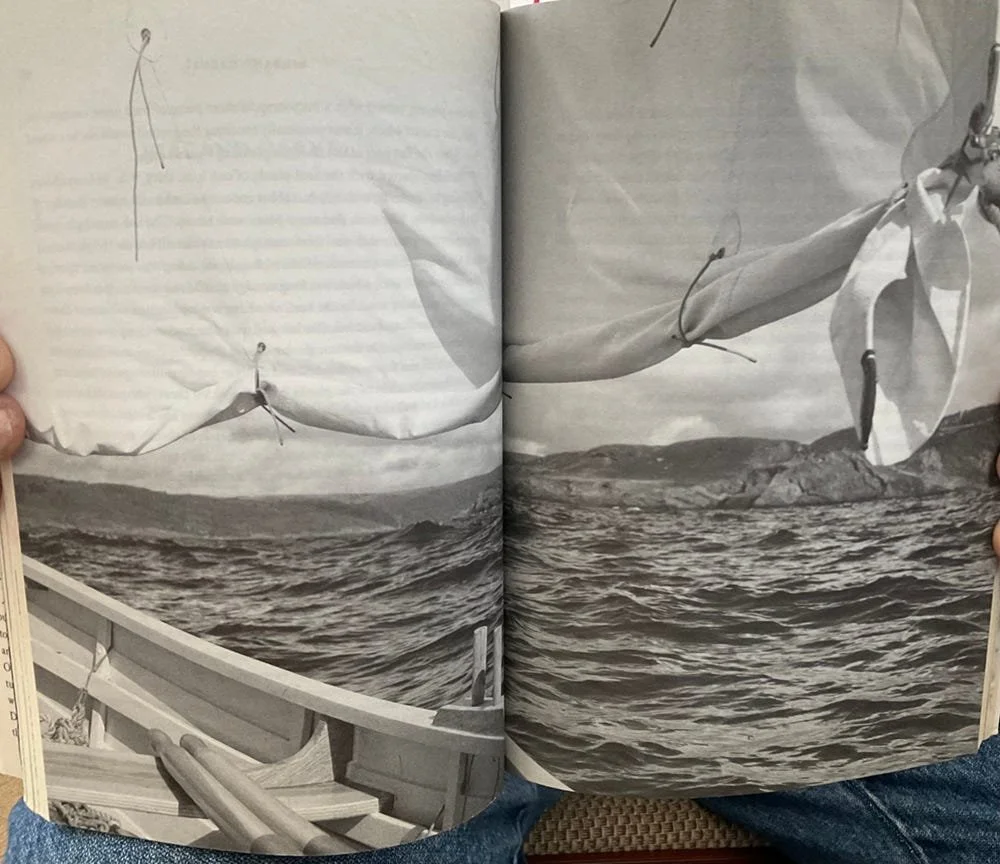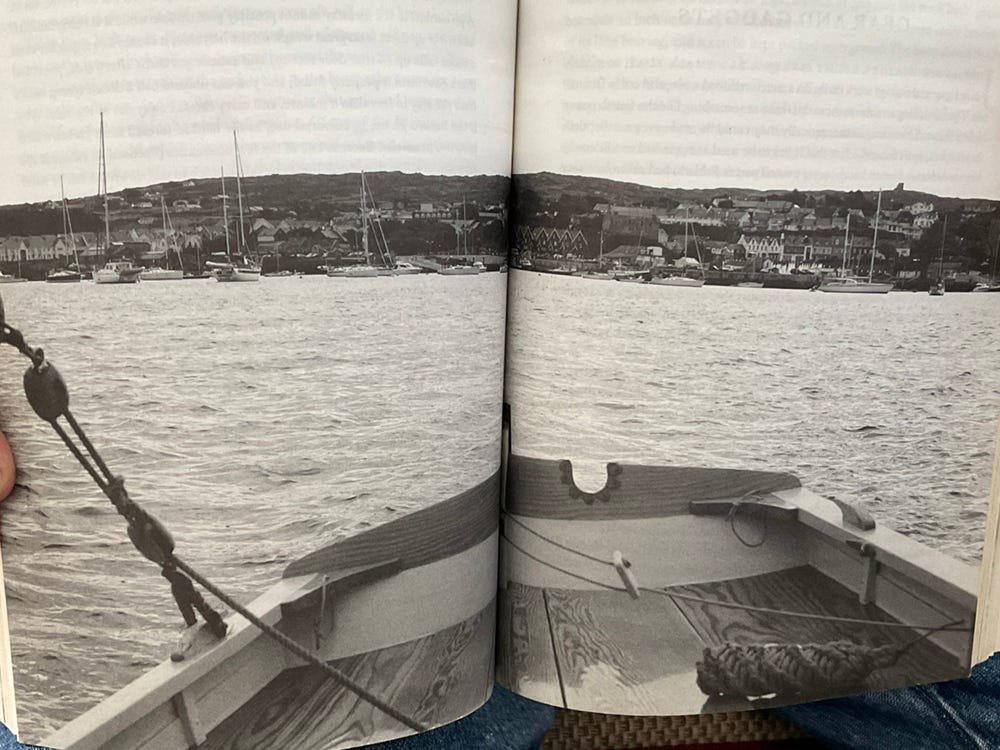Dinghy Cruising- Part II
Dinghy Cruising Part I was published in SWS two weeks ago. In it, I outlined the factors that make dinghy cruising interesting, fun, relatively inexpensive and meaningful, realising that messing about in small boats never really needs to be justified.
I also mentioned and highlighted a cruising dinghy design by a French boat designer named Francois Vivier. In this post I will continue to focus on Vivier’s ILLUR design—a 17 foot long lugger. But please remember that there are many cruising-capable dinghies out there.
ILLUR with specifications.
The photos of ILLUR shown below are all taken from a book entitled Sea-Boats, Oars and Sails. The photos show several aspects of dinghy cruising in traditional boats that continue to be useful and relevant today.
Dinghy cruising is closely analogous to backpacking/wilderness hiking, especially in the fact that you are carrying your food, water, bedding and shelter with you-but stowed in the hull space of the dinghy—thereby leaving your back and shoulders unburdened.
Here is a brief rundown:
FOOD
Cruising dinghy (CDs from here on out), usually have a “galley box” containing a one burner camp stove, a few bowls, pots, plates utensils and basic seasonings. There is also often a second box dedicated to easily prepared foods like instant oatmeal, coffee/tea, crackers, cheese, rice, fruit etc. (and Moon Pies).
Photo #1 above shows the forward space of an ILLUR hull’s interior, with two removable boxes fitted under a thwart. Consider these to be a galley box and a food box.
The space forward of the boxes is available for the storage of water containers, air mattress, bedding, spare clothing, fuel for the camp stove and a neatly folded boom tent, as well as an anchor, assorted fenders and necessary cordage (See BOOM TENT below). And, of course, a small cooler for bacon and beer.
REST
This refers primarily to an air mattress(s) and sleeping bag(s), rolled up and stowed in a water-proof bag(s). The bedding is deployed for sleeping on the floor boards of the dinghy, underneath the thwarts and is always rolled up and neatly lashed down (like everything else) before getting under way.
SHELTER
This can be as simple as a tarp hung over the boom, or the yard on a lugger, which is raised or lowered to a sitting-head height (4 1/2 to 5 feet), supported at the mast by the main halyard and supported back aft by a boom crutch—often a simple X-shaped scissor device resting on either side of the stern thwart and easily stowed flat for storage when not in use.
On his personal ILLUR Roger Barnes has a custom-made but still very simple waterproof canvas tarp with side panels. Supported as described above, it also goes around the mast with a tight lashing and attaches to the topsides—outboard—using hooks screwed into the planking. All this gives greater privacy and protection from wind and rain, very effectively converting the open hull space into a cozy private space. (Go to Youtube for Roger Barnes Dinghy Cruising and you will soon see the boom tent.)
I am not so sure at all about having a row of hooks screwed into the topsides, but it works for Roger.
ROWING/SCULLING
CDs are often referred to as “sail and oar type boats”, so lets explore that. But first, understand that it is acceptable to use a small internal combustion or electric outboard motor for auxiliary power if you want to, just think through the challenges of safely carrying and storing fuel or battery charging technology. (Also be careful with Lithium Ion batteries, they do not seem to like getting wet.)
Look carefully at Photo #2 and track across from right to left.
At 2 o’clock, upper right corner, there is a simple wooden block, one of two, for the mainsheet, attached to the clew grommet on the leech. There is NO BOOM because it is a standing lug sail.
(More about this below.)
At 6 o’clock you will see a pair of thole pins, the traditional precursors of oar locks. Below the thole pins you will see two oars lying fore and aft on top of the thwarts. Above the oars is the reefed foot of the lug sail.
You will always, with only one exception, need to use two oars, so it would be prudent (a term not used very much these days) to carry three oars, just in case one floats away or breaks. The one exception where only one oar is enough is Sculling.
Sculling, in my experience, is very seldom seen or done in the U.S., especially on the West Coast and the Gulf Coast,
It is seen and done regularly in England, Asia, the Bahamas and probably also in Ireland and Scandinavia. It is quiet, contemplative and useful, even for large vessels. It is similar to rowing, but more artful and no thole pins are required. Try it.
The Lug Rig.
In Dinghy Cruising Part I I referenced the “simple genius” of the lug rig. That may have been an artful turn of phrase but it was not at all specific, so I will try to clarify. I like the lug rig (but you are not required to ) because of its tradition and simplicity.
1. It has a short, unstayed mast and a simple yard to raise and spread the sail. You can wrap the sail around the yard and still use the yard as a ridge pole for the cockpit tarp tent.
2. There are 3 types of lug rig, Dipping, Balanced and Standing. The Balanced has a boom, the other two do not. The Dipping is very powerful, but also awkward and mostly outmoded. (See Tom Cunliffe video entitled The Reaper.)
3. Illur has a Standing lug rig. Look at Photo #3, especially at the two-part handy billy on the clew of the sail. This handy billy (what a lubber might call a block and tackle), is the simple but powerful purchase for the main sheet, which on an ILLUR controls a sail of 129 square feet.
The block on the upper part of the handy billy is connected to the clew of the sail; there are several ways to this, some traditional, some more modern and hardware centric. The block on the lower end of the handy billy has a strong, served eye splice Strop that allows it to be placed on and held in place by a thumb cleat. (See Photo #3, two thumb cleats, P&S.)
The beauty, the wisdom of hundreds of years of common sense practicality, are all quietly exhibited in this simple solution.
There is NO horse or traveler for the main sheet or tiller to run afoul of.
There is NO main sheet block flying across the cockpit to smack you in the Beezer.
There is NO boom coming across to clunk the kids or the dog in the eye.
It works like this: when tacking, as you pass through the eye of the wind just put your hand on the lower block of the handy billy and when you feel the strain come off of it, remove it—slip it off of the thumb cleat then pass it across your body and slip it onto the thumb cleat on the opposite quarter.
This takes about 2 seconds, at most.
The exact same procedure is used when you gybe; just feel the sheet go slack, take it off one side and, as the sail comes across (without a bloody great boom), slip it onto the other thumb cleat. NO DRAMA.
When you look at the Roger Barnes videos you will see this taking place. Watch closely, it is done very casually and quickly.
In conclusion, I will say that the popularity of dinghy cruising seems to have a lot to do with the fact that it is less expensive, less demanding and much more easily done than keeping, maintaining and sailing larger vessels.
This is the reality at the centre of the expression “The smaller the boat, the more often it is used.”
I believe that sailing and cruising a simple, well-founded, stable dinghy is a very good and safe introduction to the basics of cruising—as opposed to racing—that encourages learning and experimenting with oars, halyards, sheets and tillers—all of it done with the kids close at hand and not 30 feet away up in the bows.
Smaller scale is less complicated and less intimidating, thereby providing more opportunities for success. Similarly, simple, traditional rigs and fittings offer a better chance to understand how everything works.
Roger Barnes succinctly summarises the appeal of dinghy cruising as offering “simplicity and directness of experience”. Enough said.
PAU
Duncan Blair
As always, all ideas and comments are mine alone.
Credits:
Illustration #1 and all Photos are taken from Sea-Boats, Oars and Sails by Conor O’Brien. Originally published in 1941, it is now available in paperback from Lodestar Books, with photographs by Tim Cooke., 2013. If you can find a copy of either edition, grab it up.
Youtube Videos by Roger Barnes, The Dinghy Cruising Companion Series. Must See
Youtube videos Tom Cunliffe , 5 Boats That Built Britain; The Reaper.




